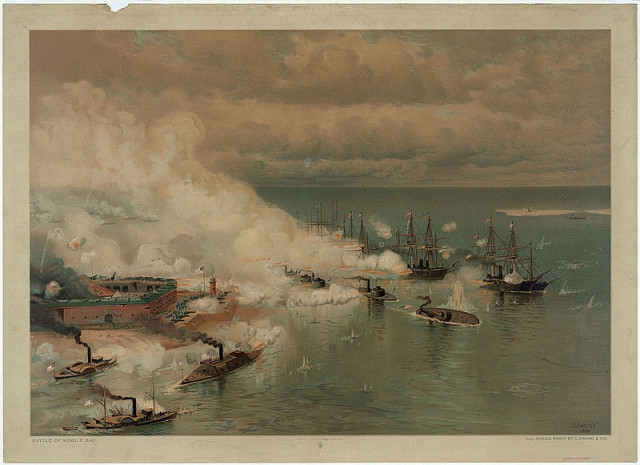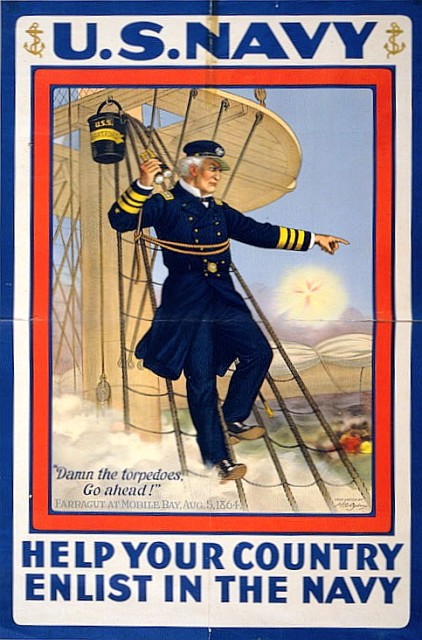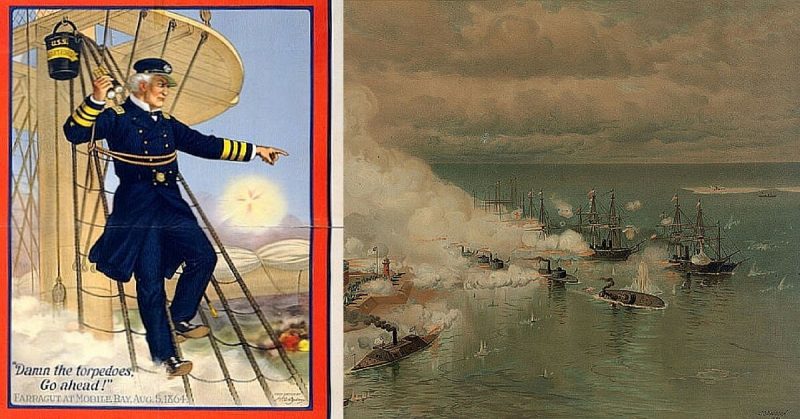The Battle of Mobile Bay was a naval battle of the American Civil War, which held great strategic importance in the summer of 1864. It was important because Mobile Bay was the last Confederate port in the Gulf of Mexico.
Subsequently, the port became one of the most important centers for blockade runners, secretly shipping supplies in and out, since the Confederate harbors were under Union naval blockade since 1861. The Confederation of States of America lacked industry and relied on the import of essential goods, such as guns and other ordinance and basic supplies for which they gave tobacco and cotton.
As an important lifeline for Confederate supplies Mobile Bay was protected by three forts – Fort Morgan, Fort Gaines and Fort Powell, which was the smallest of the three and the last one to be built, serving as a guard post for one of the canals.
Also 67 naval mines, or “torpedoes” were planted across the bay, with a gap on the east side, so that Confederate ships could pass. The minefield was marked with buoys which made it visible for the attackers. The idea was that the attacking ships would try to avoid the minefield, but then fall within the range of the guns stationed on the Fort Morgan.
Addition to the land defense of the Bay in 1864, was a small flotilla led by the ironclad CSS Tennessee and consisted of three more gunboats. CSS Tennessee was carrying six cannons and had far more impressive iron armor than the Union ships. The Confederate naval forces were under the command of Admiral Franklin Buchanan, and the land defense was in the hands of Brigadier General Richard L. Page, who was given the command in the absence of its original commander, Major General Dabney H. Maury.
The Union admiral who was trusted with the mission of securing the Bay of Mobile was David Farragut. Farragut was an experienced seaman, starting his career in War of 1812, at the age of nine, when he served as a midshipman aboard the USS Essex. In 1822, he was a lieutenant battling the pirates in the West Indies and during the Mexican-American War, he was a full captain commanding the USS Saratoga.

He commanded a fleet of 18 vessels – 9 of them were wooden-hulled battleships carrying a large number of guns that fired cannon broadsides, 2 gunboats and 3 more double-enders developed during the war as light vessels that can navigate through the narrow channels of interior rivers. Finally, four of his warships were the representatives of the ‘New Navy’ – the ironclad monitors, USS Tecumseh and USS Manhattan, USS Chickasaw and USS Winnebago.
The Admiral himself was aboard the flagship, Hartford. Farragut had numerical superiority, but the position seemed to be well defended. The only thing that he could count on was the low morale of the troops defending the forts, for it was obvious in 1864 that the War was coming to its end in favor of the Union.
On August 3, the Army landing force under the command of General Gordon Granger was ready to embark the shore of Dauphin Island to start a siege of Fort Powell, but Farragut wanted to wait for his fourth monitor, USS Tecumseh, expected at any moment but delayed at Pensacola. After the Tecumseh finally arrived it went on the attack on August 5.
By mistake or by some other agent of fate the ship went directly across the minefield, instead of maneuvering to the east. The ship hit one of the torpedoes and sank almost instantly. Of the ship’s crew of 93, only 21 of them were saved. Among the dead was the commander of the USS Tecumseh, Tunis A.M Craven and it was never discovered what led him to order his ship across the mined waters, which was almost suicidal.
At this moment Farragut made a decision to run the entire fleet through the minefield, thus avoiding the fort cannons. He has estimated that the torpedoes, even though one of them had just sunk USS Tecumseh, were submerged for too long and that most of them weren’t effective anymore.
It is claimed that he gave the order: “Damn the torpedoes, full speed ahead,” which became a memorable quote in naval history. By most sources this particular statement was never actually pronounced, but Farragut did take his chance across the minefield and succeeded to go through it. His gamble paid off and his ships were unharmed. After his daring move, he was met by the pride of the Confederate navy, CSS Tennessee.

Tennessee wanted to take out the fleet singlehandedly by ramming into Union ships with its steel front. It ended badly for Tennessee for, even though it was superior in armor, its firepower could not harm the Union monitor vessels. Thus, it came to a stalemate, after, a period of time, the Confederate ships surrendered eventually being too damaged to continue, the battle.
During the battle, Admiral Farragut climbed up the mast and was tied to it so he wouldn’t fall, for a better overview of the situation, since the smoke coming out of the guns blurred his sight. This gesture was seen as the ultimate act of bravery by the ship’s captain, for in case of sinking, he would go down with the ship, even though he allegedly forgot to think of such consequences in the heat of the battle.

With the fleet out of commission, Farragut could concentrate his firepower on supporting the siege of Forts. He captured the CSS Tennessee, renaming it USS Tennessee and started the bombardment of the bay. Fort Powell and Fort Gaines soon surrendered. The siege of Fort Morgan lasted for two weeks, in general, it was only a series of minor skirmishes and ended with the surrender of the Confederate defenders.
Farragut managed to conquer the forts defending the city of Mobile but hesitated to attack the city itself for it was well defended. Due to this decision, the victory was somewhat overlooked in the Union press, even though it represented an important step in ending the war.
